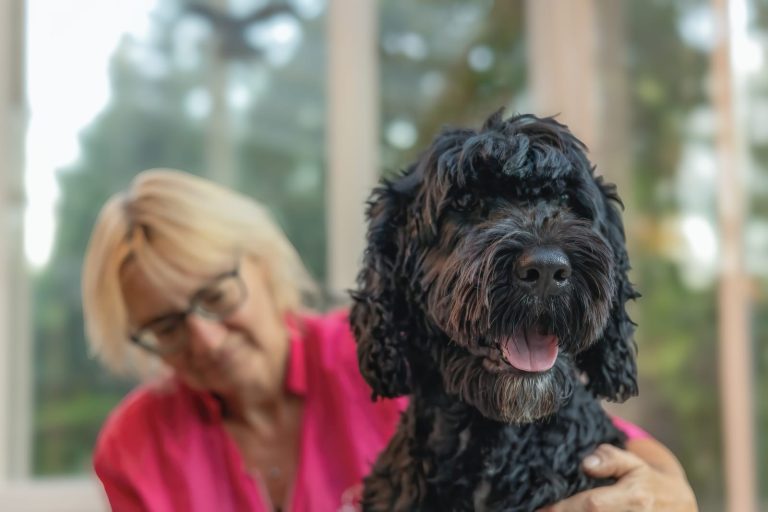Portuguese Water Dogs and Spanish Water Dogs have distinct histories and traits. These breeds share some similarities but differ in key ways. Let’s explore both those dog breeds!
If you’re still on the market to buy one of these dog breeds, PuppySpot currently offers a $300 discount using the code PUPPY300, just click the banner below!
Physical Characteristics and Size
- Portuguese Water Dogs are bigger than Spanish Water Dogs. Portuguese Water Dogs have curly or wavy coats that don’t shed much. Their fur can be black, brown, or white.
- Spanish Water Dogs have curly coats that form cords if not trimmed. Their fur comes in black, brown, white, or beige.
- Both breeds have webbed feet for swimming. This helps them move well in water.
Temperament Traits
- Portuguese Water Dogs are smart and energetic. They love to play and need lots of exercise. These dogs are loyal to their families and good with kids.
- Spanish Water Dogs are also bright and active. They can be more protective and wary of strangers. This makes them good watchdogs.
- Both breeds need mental and physical stimulation. They enjoy training and water activities. Without enough exercise, they may become bored and act out.
- These dogs form strong bonds with their owners. They do best with active families who can give them attention and exercise.
Comparative Anatomy
Portuguese Water Dogs and Spanish Water Dogs have distinct physical traits that set them apart. Their unique features make them well-suited for aquatic activities and contribute to their swimming abilities.
Coat Type Variations
- Portuguese Water Dogs have curly or wavy coats that require regular grooming. Their fur can be kept long or trimmed short in a “lion cut” style. This coat type helps protect them from cold water.
- Spanish Water Dogs, on the other hand, have woolly, corded coats. Their fur naturally forms cords as they grow older. This unique texture helps repel water and keeps them warm in chilly conditions.
- Both breeds have hypoallergenic coats, making them suitable for people with allergies. Regular grooming is essential for both to maintain their coat health and prevent matting.
Distinctive Features: Webbed Feet and Coat
Both Portuguese and Spanish Water Dogs have webbed feet, which gives them an advantage in swimming. These webbed toes act like flippers, helping them move efficiently through water.
Portuguese Water Dogs typically have:
- Larger, more muscular bodies
- Broader chests
- Longer snouts
Spanish Water Dogs are characterized by:
- Slightly smaller frames
- More compact bodies
- Shorter muzzles
These physical differences affect their swimming styles. Portuguese Water Dogs tend to be stronger swimmers due to their larger size and muscular build. Spanish Water Dogs are agile and quick in the water, thanks to their compact bodies.
Exercise and Activity Requirements
Portuguese Water Dogs and Spanish Water Dogs need lots of exercise and mental stimulation. They love to swim and play in water. Both breeds have high energy levels that owners must manage.
Energy Levels and Mental Stimulation
- Portuguese Water Dogs are very energetic and need plenty of activity. They require at least an hour of exercise daily. This can include walks, runs, or playtime in a fenced yard.
- Spanish Water Dogs also have high energy levels. They need active, engaged lifestyles to stay happy and healthy. Both breeds benefit from mental challenges like puzzle toys or training sessions.
- Without enough exercise, these dogs may become bored and destructive. Owners should plan for daily physical activity and brain games to keep their pets content.
Swimming Abilities and Water Activities
Both breeds excel at swimming and water-based activities. Portuguese Water Dogs were bred to help fishermen and are strong swimmers. They often enjoy:
- Retrieving games in water
- Dock diving
- Paddleboarding with their owners
Spanish Water Dogs also love water activities. They were originally used to help herd animals near water. These dogs enjoy:
- Swimming in lakes or pools
- Fetching toys from water
- Accompanying owners on boat trips
Regular water play helps meet their exercise needs and taps into their natural instincts. Both breeds thrive when given chances to swim and play in water often.
Grooming and Care
Both Portuguese and Spanish Water Dogs have unique grooming needs due to their distinct coat types. Their maintenance requirements differ in terms of shedding, allergenic properties, and regular care routines.
Shedding and Hypoallergenic Qualities
- Portuguese Water Dogs are known for their low-shedding coats. This quality makes them a good choice for people with allergies. Their fur doesn’t produce much dander, which is often the cause of allergic reactions.
- Spanish Water Dogs also shed minimally. They have a dense, wool-like coat that traps loose hair. This means less fur around the house, but it can lead to matting if not properly cared for.
- Both breeds are considered hypoallergenic. However, no dog is 100% allergy-free. Regular grooming helps reduce allergens in both breeds.
Grooming Needs and Maintenance
- Portuguese Water Dogs require regular brushing to prevent tangles and mats. Their coat can be kept in a retriever clip (shorter all over) or a lion clip (longer in some areas). Professional grooming every 4-8 weeks is recommended.
- Spanish Water Dogs have unique grooming needs. Their coat naturally cords if left ungroomed. Some owners prefer this look, while others opt for regular trimming. Professional grooming is often necessary due to their thick, dense coat.
- Both breeds need regular nail trims and ear cleanings. Their ears should be checked often, especially after swimming, to prevent infections.
Training and Socialization
Both Portuguese and Spanish Water Dogs are smart and trainable breeds. They need proper training and social skills to thrive as pets.
Trainability and Positive Reinforcement
- Portuguese Water Dogs are highly trainable. They pick up commands fast and love to please their owners. These dogs do well with positive reinforcement like treats and praise.
- Spanish Water Dogs are also smart but can be more stubborn. They need a firm hand in training. Spanish Water Dogs respond best to positive methods too. Harsh training can make them shut down.
- Both breeds excel in obedience training. They can learn complex tasks and tricks. Early training is key for both types of water dogs. This helps them grow into well-behaved adult dogs.
Social Behaviors and Compatibility
- Portuguese Water Dogs are very social. They love being around people and other pets. These dogs fit well in active families. They need lots of play and exercise to stay happy.
- Spanish Water Dogs can be more reserved with strangers. They bond closely with their family but may be wary of new people. Early socialization helps Spanish Water Dogs feel at ease in different settings.
- Both breeds can get along with other pets if raised together. Portuguese Water Dogs tend to be more outgoing in group settings. Spanish Water Dogs may prefer a calmer home environment.

Health and Longevity
Portuguese Water Dogs and Spanish Water Dogs are generally healthy breeds. They share some common health concerns but differ in their expected lifespans.
Common Health Issues
- Both breeds can face hip dysplasia, a genetic condition affecting the hip joint. Portuguese Water Dogs may develop Addison’s disease, a hormonal disorder. They can also suffer from cataracts, which affect vision.
- Spanish Water Dogs are prone to progressive retinal atrophy (PRA), an eye condition that can lead to blindness. Entropion, where the eyelid rolls inward, is another issue they may face.
- Regular vet check-ups are crucial for both breeds. Early detection of these health problems can lead to better management and treatment outcomes.
Lifespan Expectancy
- Portuguese Water Dogs typically live 10-14 years. Spanish Water Dogs have a slightly longer average lifespan of 12-15 years.
- Proper diet, regular exercise, and good healthcare can help extend a dog’s life. Both breeds benefit from an active lifestyle that includes swimming and other physical activities.
- Genetic testing can help identify potential health risks early on. This allows owners to take preventive measures and provide targeted care for their pets.
Behavioral Characteristics
Portuguese Water Dogs and Spanish Water Dogs have distinct behavioral traits that set them apart. These characteristics influence their roles as working dogs and family companions.
Watchdog and Protective Instincts
- Both breeds display strong watchdog abilities. Portuguese Water Dogs are known to be more outgoing and sociable, making them excellent family guardians. They alert their owners to potential threats but rarely show aggression.
- Spanish Water Dogs tend to be more reserved with strangers. This trait enhances their natural guarding instincts. They are protective of their families and territory, making them effective watchdogs.
- Both breeds are trainable for protection work. Their intelligence and loyalty make them quick learners in this area. However, proper socialization is crucial to prevent overly protective behaviors.
Herding and Hunting Skills
- Portuguese Water Dogs excel in water-based tasks. They were bred to assist fishermen, retrieving lost gear and herding fish into nets. This background translates into strong swimming abilities and a natural retrieving instinct.
- Spanish Water Dogs have a diverse skill set. They were used for herding livestock and as hunting companions. Their agility and keen sense of smell make them adept at flushing out game.
- Both breeds retain their working dog instincts. This can manifest as herding behaviors towards children or small animals. Proper training channels these instincts into positive activities.
Adaptability to Living Environments
Both Portuguese and Spanish Water Dogs can adapt to different living situations. Their ability to adjust depends on factors like space, family structure, and activity level.
Apartment Versus House Living
- Portuguese Water Dogs are generally more adaptable to apartment living. They can do well in smaller spaces if given enough exercise. These dogs need daily walks and playtime to stay happy.
- Spanish Water Dogs may prefer houses with yards. They enjoy having more space to roam and explore. However, they can adjust to apartment life with proper care and attention.
- Both breeds thrive with an active lifestyle. Regular exercise is key for their well-being in any living environment. Without enough activity, they may become restless or destructive.
Adjusting to Different Family Structures
- Portuguese Water Dogs are known for their friendly nature. They typically adjust well to various family types. These dogs can be great with children, singles, or seniors.
- Spanish Water Dogs may be more reserved with strangers. They often form strong bonds with their primary caregiver. This breed can be protective of their family.
- Both breeds can be good family pets. They need consistent training and socialization from an early age. This helps them adapt to different people and situations.
- Portuguese Water Dogs may be more outgoing with visitors. Spanish Water Dogs might take longer to warm up to new people in the home.





